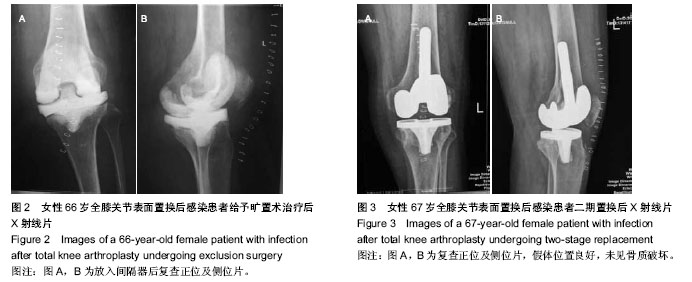| [1] 徐红伟,陆惠根.膝关节置换术后感染因素分析[J].中华医院感染学杂志,2012,22(5):929-930.
[2] Spangehl MJ, Masri BA,O’Connell JX,et al. Prospective analysis of preoperative and intraoperative investigations for the diagnosis of infection at the site of two hundred and two revision total hip arthroplasties.J Bone Joint Surg Am. 1999; 81(5): 627-683.
[3] 陈金民,丁晶.全膝关节置换术后感染诊断的研究进展[J].西南国防医药,2010,20(2):213-215.
[4] Kurtz SM, Ong KL, Lau E, et al. Prosthetic joint infection risk after TKA in the Medicare population. Clin Orthop Relat Res. 2010;468(1):52-56.
[5] 方恺.人工膝关节置换后的假体周围感染[J].中国组织工程研究与临床康复,2010,14(30):5650-5653.
[6] Azzam K, Parvizi J, Jungkind D, et al.Microbiological, clinical, and surgical features of fungal prosthetic joint infections:a multi-institutional experience. J Bone Joint Surg Am. 2009;6:142-149.
[7] 黄强开,杜少华,卫小春,等.白介素6对于早期诊断关节置换术后假体周围感染的意义[J].中华关节外科杂志:电子版,2012,6(3):74-76.
[8] Buttaro MA, Tanoira I, Comba F, et al. Combining C-reactive protein and interleukin 6 may be useful to detect per prosthetic hip infection. Clin Otthop Relat Res. 2010;468(12):3263-3267.
[9] KÖsters K, van Crevel R, Sturm PD, et al. Treatment of knee prosthesis infections:evaluation of 15 patients over a 5-year period. Int Orthop.2009;33(5):1249-1254.
[10] Bernard L, Legout I, Zurcher-Pfund L, et al. Six week of antibiotic treatment is sufficient following surgery for septic arthroplasty. Infect. 2010;61:125-132.
[11] Bedair H, Ting N, Jacovides C, et al. Diagnosis of early postoperative TKA infection using synovial fluid analysis.Clin Orthop Relat Res. 2011;469:34-40.
[12] Lee JK, Choi CH.Two-stage reimplantafion in infected total knee arthroplasty using a re-sterilized tibial polyethylene insert and femoral component. J Arthroplasty. 2012;27: 1701-1706. |



